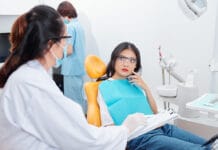Diagnostic errors are a serious concern in health care settings. Though many people may only think of diagnostic errors from a medical viewpoint, dentistry also has its fair share of diagnostic errors. It has been estimated that around 24% of patients who experienced a diagnostic error in dentistry experienced an adverse event that led to permanent harm.1
The National Academy of Medicine defines diagnostic errors as “the failure to (a) establish an accurate and timely explanation of the patient’s health problem(s) or (b) communicate that explanation to the patient.”2
A qualitative study utilized social media to investigate patients’ experiences of dental diagnostic failures. Through social media, the authors had 756 individuals take the initial survey. Of those, 396 were eligible based on inclusion criteria. However, only 161 individuals provided a written description of their experience. Of those, 67 completed a telephone interview.3
The following is what was discovered in the study.3
Screening Survey
The initial survey asked questions in plain language to improve participants’ understanding for more accurate answers. The aim was to capture patient experiences that were potentially associated with dental diagnostic errors. The screening survey asked the following questions:3
- Have you ever given up on finding a cause for your dental symptoms or problem?
- 44% indicated yes.
- Has any dentist ever told you that your previous dentist made a mistake with the diagnosis of your dental symptoms or problem?
- 53% indicated yes.
- Have you ever felt that your dentist made a mistake with the diagnosis of your dental symptoms or problems?
- 2% indicated yes.
- Has there ever been a delay in finding a diagnosis for your dental symptoms or problem?
- 4% indicated yes.
- Have you visited multiple dentists for the same dental symptoms or problems and received different opinions about the diagnosis?
- 5% indicated yes.
- Have you ever had dental symptoms or problems (toothache, swelling, ulcer) that you feel your dentist was not able to tell you why it started?
- 5% indicated yes.
Even if some of these answers are not entirely accurate, the patient’s perception should still be considered. We all know and have experienced cases where patients misinterpret or misremember events that occurred. Nonetheless, their perception remains important in reducing dental diagnostic failures and improving patient outcomes. A poor perception of dental professionals could lead patients to avoid seeking care. Therefore, this article aims to challenge dental professionals to consider the patient’s perception as a crucial factor in delivering safe care and accurate, timely diagnoses for improved treatment outcomes.
Results
Each participant was asked to describe their experience with dental diagnostic failures. After reviewing the responses, five themes were identified: clinical presentation, initial diagnosis and treatment, sequalae, correct diagnosis, and concurrent treatment errors.3
Clinical Presentation
In most cases, the catalyst for the dental diagnostic failure was the patient’s chief complaint. Chief complaints included toothache/pain within the oral cavity, tooth sensitivity, swollen/inflamed gingiva, chipped or cracked teeth, bleeding within the oral cavity, and facial pain outside the oral cavity. Some were also the result of an incidental finding during a routine preventive appointment where the patient presented with no chief complaint or symptoms.3
Participants provided feedback on observations about their provider that they felt influenced the development of the diagnostic error. These observations included poor communication, inadequate time with patients, and financial incentives.3
The most common observation was that their dental provider seemed rushed, leading to insufficient time spent discussing and properly diagnosing the patient’s concerns. Further, this time constraint affected the patient-clinician relationship and further contributed to the inability to properly educate the patient in a way that was easily understood. Other concerns expressed by patients included a lack of knowledge and experience.3
As a result of the patient’s experience with diagnostic errors, most reported changes in their care-seeking behavior, including a desire to change their primary dentist, practicing more caution when selecting a dentist, and increased self-advocacy. For some patients, the experience made them more eager to improve their oral health literacy. Most patients disclosed a loss of trust in the dentist implicated in the diagnostic error.3
Most patients reported sharing their experiences with community members. They felt spreading the word about their experience may prevent it from happening to others. The primary goal stated by patients who shared their experience was that they wanted the provider to take accountability and gain awareness in hopes of preventing future diagnostic errors. According to the study participants, the most appropriate avenues for reporting the diagnostic error were speaking directly with the dental office, informing the state dental boards, or utilizing an online platform.3
Initial Diagnosis and Treatment
In addition to a clinical exam, the most common diagnostic measure taken was radiographs prior to diagnosis. In a few cases, a CBCT and pulp test were utilized. The top diagnosis was dental caries and/or gingivitis/periodontal disease. One-quarter of the participants reported that they failed to receive a diagnosis or were told there was no pathology or disease present, which led to a delayed diagnosis.3
The most common initial treatment modalities employed included medication prescriptions or restorations. The most commonly prescribed medications were antibiotics. Some patients reporting pain were also given analgesics for palliative care. Patients also reported being “prescribed” better oral hygiene, and in some cases, they were recommended to have a “deep cleaning” completed.3
Participants of the study reflected on their own role in the diagnostic error. Many cited their own shortcomings, including a lack of self-advocacy, poor choice of provider or clinic, and lack of dental health literacy. Many expressed that the reason for their lack of advocacy was directly related to their lack of dental knowledge. Female patients were three times more likely to fault themselves for a lack of self-advocacy than male counterparts. Some participants thought seeking a second opinion could have prevented the diagnostic error.3
Most of the participants stated that the diagnostic error created increased financial stress. Specific financial concerns expressed included insurance coverage challenges, payment for additional dental work, and having to take time off work/decreased productivity. Interestingly, this applied to all income levels.3
Sequalae
Some of the most profound and prominent consequences reported by the participants included prolonged suffering, disease progression, unnecessary treatments, and the development of new symptoms or comorbidities. Participants reported receiving two or more referrals or second opinions throughout the diagnostic error experience. This led to some reports of multiple diagnostic errors. The most reported new symptom development was infection/development of abscess.3
Though the primary focus was on the clinician-patient factors, some reported system influences contributed to the sequelae of the diagnostic error. The most often mentioned system influence was insurance coverage limitations. Participants specifically implicated that insurance coverage challenges hindered patients’ ability to choose a specific provider or affected accessibility to certain treatment options. To a lesser degree, participants reported scheduling challenges and the use of outdated or inappropriate equipment.3
A majority of the participants disclosed that the diagnostic error affected their everyday lives. This included the ability to eat, rest, communicate, and participate in personal hygiene. Many also admitted they had difficulty sleeping due to severe pain. This combination of sequelae contributed to emotional stress and mental health challenges such as increased anxiety, stress, and depressed mood/depression.3
Participants suggested that dentists improve and focus on good chairside manners. Many reported visiting the dentist was anxiety-inducing. Further suggestions included providing detailed diagnostic workups and upholding ethical, evidence-based practices. Many who reported a lack of diagnostic workup faulted the dentist for the lack of time spent addressing the participant’s concerns. Participants also reported a need for dentists to improve their self-awareness of their limitations and refer patients out when necessary.3
Correct Diagnosis
Most dental diagnostic failure experiences were resolved in under six months, at which time patients received an accurate and definitive diagnosis. It was rare for a diagnostic error to persist beyond five years, though this did unfortunately happen for a small number of participants.3
The most reported diagnostic tool used to provide a correct diagnosis was radiographs. However, participants also reported a thorough medical, dental, and social history, along with a clinical examination, which also played a crucial role in detecting the initial diagnostic error.3
Nearly one-quarter of participants indicated their diagnostic error remained unresolved without a definitive diagnosis. In a few instances, it was concluded that there was no underlying pathology or disease. Often, patients were simply informed that they had sensitive teeth, or dentists took radiographs and found no issues.3
Although some cases required the expertise of a specialist, such as an endodontist or oral surgeon, most were resolved by another general dentist. Interestingly, some initial diagnostic errors were made by physicians before the patient was referred to a dentist. The most common treatments following a correct diagnosis included tooth extraction or implant removal, root canal therapy, new medications or adjustments to existing ones, and crown or other prosthetic placement.3
When asked who was culpable for the diagnostic error, most participants indicated the dentist who made the diagnostic error. Though a few reported the diagnostic error as a “no-fault occurrence,” almost none of the participants suggested their personal role when reporting culpability.3
After experiencing a diagnostic error, participants reported developing an overall negative perception of dentists. Participants who reported a positive experience often attributed their positive experience to the fact that a different dentist helped identify and treat their diagnostic error. These occurrences resulted in improved confidence in dentists and a long-term patient-dentist relationship.3
Concurrent Treatment Error
One of the most daunting findings in this study was that a significant number of participants experienced a concurrent treatment error during their experience of the original diagnostic error. In almost all cases, these concurrent treatment errors were executed by the original dentist who made the diagnostic error.3
Participants were then asked if they thought the diagnostic error was preventable. In most cases, the participants reported that they believed the diagnostic error was indeed preventable.3
In Closing
As clinicians, we recognize that patients can be unreliable historians, and their recollections of events may contain inaccuracies. However, the knowledge gained from this study can help improve rapport with patients and garner trust between patients and dental professionals.
Studies show that the public’s trust in health-related sciences in the United States has significantly decreased since the COVID-19 pandemic. In 2022, only 29% of U.S. adults polled told researchers that they have a great deal of confidence that medical scientists will act in the public’s best interest. This lack of trust has carried over into clinical settings across all areas of health care. Further, when diagnostic errors occur, they are often shared in communities, which further damages the trust and rapport between clinicians and patients.4
Although avoiding diagnostic errors has always been important, the mistrust displayed by the public in health care has never been more evident. For that reason, understanding patient’s perception of the care they receive is vitally important. Identifying factors that could improve patient perception should be addressed in clinical settings.
The main takeaways that can be changed to improve patient perception include providing adequate time for appointments, acquiring proper diagnostic images, thoroughly reviewing patient’s medical, dental, and social histories, and referring to specialists sooner rather than later.
Not only could these small changes improve patient perception, but they could also potentially prevent a diagnostic error from occurring. Although we have all heard far-fetched stories from patients regarding their perceptions of events that occurred during dental care, it is vital to listen to and take their concerns seriously.
Before you leave, check out the Today’s RDH self-study CE courses. All courses are peer-reviewed and non-sponsored to focus solely on high-quality education. Click here now.
Listen to the Today’s RDH Dental Hygiene Podcast Below:
References
- Obadan, E.M., Ramoni, R.B., Kalenderian, E. Lessons Learned from Dental Patient Safety Case Reports. J Am Dent Assoc. 2015; 146(5): 318-26.e2. https://www.ncbi.nlm.nih.gov/pmc/articles/pmid/25925524/
- Hall, K.K., Shoemaker-Hunt, S., Hoffman, L., et al. Making Healthcare Safer III: A Critical Analysis of Existing and Emerging Patient Safety Practices [Report No.: 20-0029-EF]. (2020, March). Agency for Healthcare Research and Quality (U.S.). https://www.ncbi.nlm.nih.gov/books/NBK555525/#
- Obadan-Udoh, E., Howard, R., Valmadrid, L.C., et al. Patients’ Experiences of Dental Diagnostic Failures: A Qualitative Study Using Social Media. J Patient Saf. 2024; 20(3): 177-185. https://journals.lww.com/journalpatientsafety/fulltext/2024/04000/patients__experiences_of_dental_diagnostic.4.aspx
- Caplan, A.L. Regaining Trust in Public Health and Biomedical Science following Covid: The Role of Scientists. Hastings Cent Rep. 2023; 53(S2): S105-S109. https://onlinelibrary.wiley.com/doi/10.1002/hast.1531











